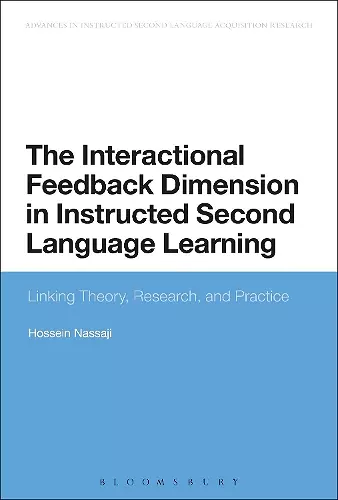The Interactional Feedback Dimension in Instructed Second Language Learning
Linking Theory, Research, and Practice
Format:Hardback
Publisher:Bloomsbury Publishing PLC
Published:12th Mar '15
Currently unavailable, and unfortunately no date known when it will be back

Identifies the developmental stages that characterize the acquisition of direct pronouns in Spanish and the effect of formal instructionof language development.
This book examines current advances in the role of interactional feedback in second language (L2) teaching and learning. Drawing on recent theory and research in both classroom and laboratory contexts, the book explores a wide range of issues regarding interactional feedback and their relevance for both theory and practice, including how interactional feedback is used, processed, and contributes to L2 acquisition. This book will provide a useful resource for applied linguistics students and academics as well as language teachers and teacher educators who would like to gain insight into the role of interactional feedback and how it can be used as a means of integrating form and meaning in classroom contexts.
The high quality of the present book resides in several factors that go beyond its mere content ... We here have a publication at hand that shows readers the high complexity of giving feedback in second and foreign language teaching. One of its merits is that it gives readers invaluable advice where this is possible ... An important textbook for (under)graduate courses in SLA and Applied Linguistics. * Journal of Linguistics and Language Teaching *
Interest in interactional feedback and its role in second language (L2) acquisition have a long history, motivated in part by teachers’ concerns about whether and how to correct L2 learners and in part by theoretical issues in the field of second language acquisition. Thus a book that brings together the different pedagogical and theoretical perspectives and the research they have given rise to is most welcome. Hossein Nassaji is to be congratulated in producing an informed, comprehensive and very readable account of this body of work. His book is notable for both its breadth of coverage and the clarity with which complex issues relating to interactional feedback are discussed. This is a book that I will be referring to frequently in my own research and in my graduate-level teaching. -- Rod Ellis, Professor of Applied Language Studies and Linguistics, University of Auckland, New Zealand
Nassaji has reviewed and analyzed hundreds of publications exploring the role of interactional feedback in second language learning. The book covers a range of theoretical perspectives and draws on research with young learners and adults, in classrooms and laboratory settings. Nassaji shows how the research findings can guide teachers in answering important pedagogical questions about how to respond to the errors their students make. -- Patsy M. Lightbown, Distinguished Professor Emeritus of Applied Linguistics, Concordia University, Canada
Hossein Nassaji’s book provides an excellent and detailed review of interactionist theory and research (descriptive, experimental and comparative) related to the role of feedback in classroom-based language learning. Particularly useful is that Nassaji links theory and empirical findings to pedagogical implications, providing suggestions for enhancing the effectiveness of feedback for second language learning. Each chapter usefully begins with a set of goals for that chapter and ends with a set of discussion questions. -- Merrill Swain, Professor Emeritus of Second Language Education, The Ontario Institute for Studies in Education, University of Toronto, Canada
ISBN: 9781472510143
Dimensions: unknown
Weight: 372g
264 pages